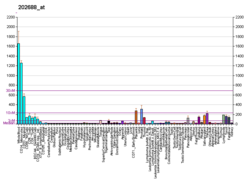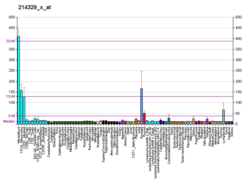In the field of cell biology, TNF-related apoptosis-inducing ligand (TRAIL), is a protein functioning as a ligand that induces the process of cell death called apoptosis.[5][6]
TRAIL is a cytokine that is produced and secreted by most normal tissue cells. It causes apoptosis primarily in tumor cells,[7] by binding to certain death receptors. TRAIL and its receptors have been used as the targets of several anti-cancer therapeutics since the mid-1990s, such as Mapatumumab. However, as of 2013, these have not shown significant survival benefit.[8] TRAIL has also been implicated as a pathogenic or protective factor in various pulmonary diseases, particularly pulmonary arterial hypertension.[9]
TRAIL has also been designated CD253 (cluster of differentiation 253) and TNFSF10 (tumor necrosis factor (ligand) superfamily, member 10).[7]
- ^ a b c GRCh38: Ensembl release 89: ENSG00000121858 – Ensembl, May 2017
- ^ a b c GRCm38: Ensembl release 89: ENSMUSG00000039304 – Ensembl, May 2017
- ^ "Human PubMed Reference:". National Center for Biotechnology Information, U.S. National Library of Medicine.
- ^ "Mouse PubMed Reference:". National Center for Biotechnology Information, U.S. National Library of Medicine.
- ^ Wiley SR, Schooley K, Smolak PJ, Din WS, Huang CP, Nicholl JK, Sutherland GR, Smith TD, Rauch C, Smith CA (December 1995). "Identification and characterization of a new member of the TNF family that induces apoptosis". Immunity. 3 (6): 673–82. doi:10.1016/1074-7613(95)90057-8. PMID 8777713.
- ^ Pitti RM, Marsters SA, Ruppert S, Donahue CJ, Moore A, Ashkenazi A (May 1996). "Induction of apoptosis by Apo-2 ligand, a new member of the tumor necrosis factor cytokine family". The Journal of Biological Chemistry. 271 (22): 12687–90. doi:10.1074/jbc.271.22.12687. PMID 8663110.
- ^ a b "TNFSF10". NCBI Gene.
- ^ Cormier Z (February 2013). "Small-molecule drug drives cancer cells to suicide". Nature. 494. doi:10.1038/nature.2013.12385. S2CID 76236123.
- ^ Braithwaite AT, Marriott HM, Lawrie A (2018). "Divergent Roles for TRAIL in Lung Diseases". Frontiers in Medicine. 5: 212. doi:10.3389/fmed.2018.00212. PMC 6072839. PMID 30101145.







